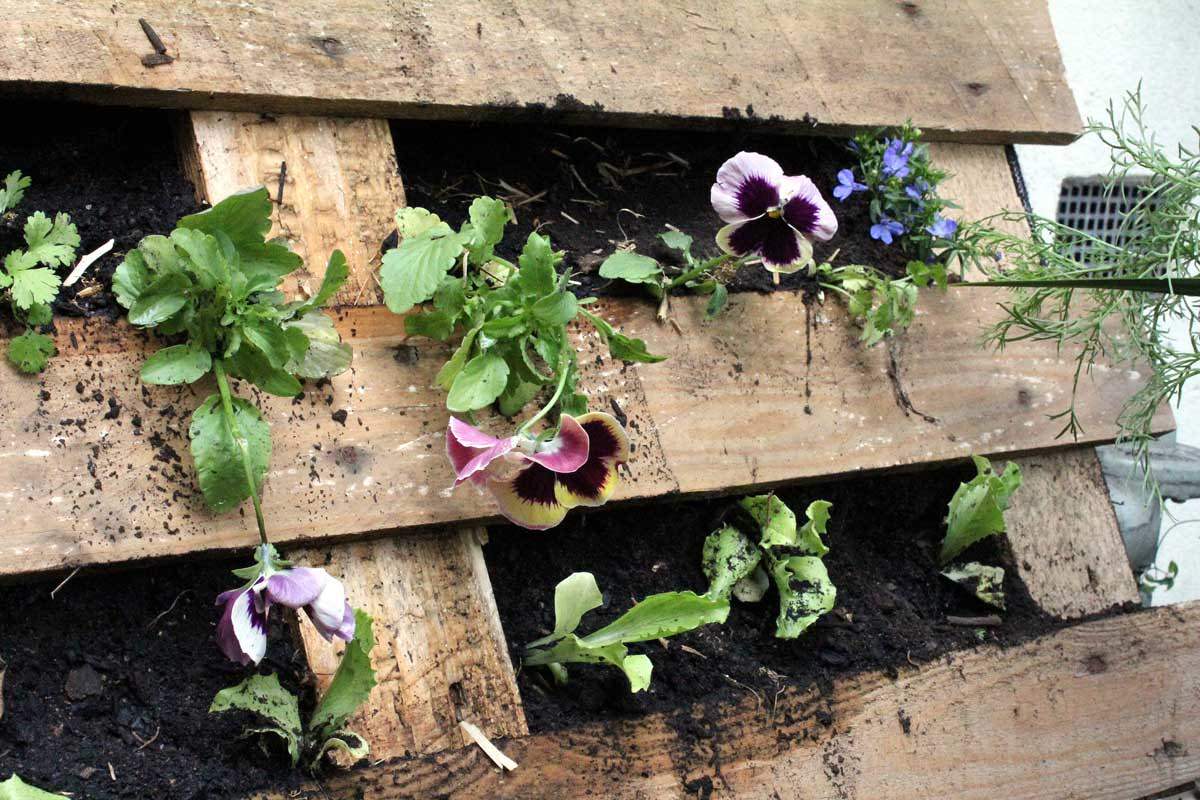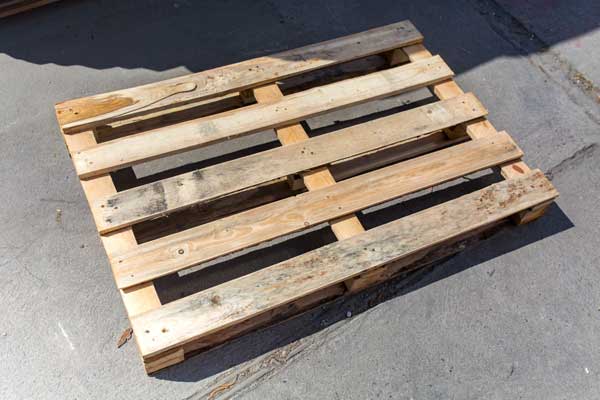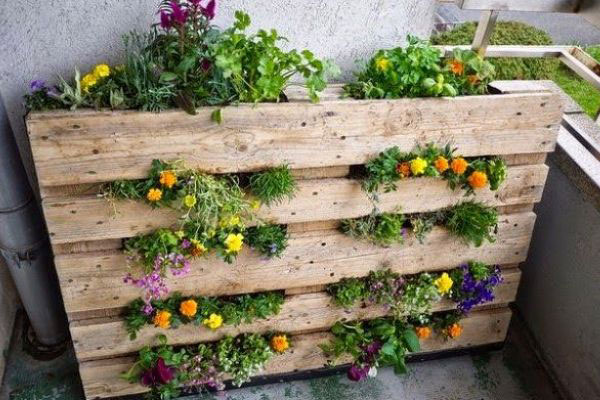How to Make a Pallet Garden
Who wouldn’t want to grow herbs and veggies on the wall of their house?
How to Make a Pallet Garden
Who wouldn’t want to grow herbs and veggies on the wall of their house?

Not surprisingly, an entire cottage industry has sprung up in recent years to re-purpose all those pallets, turning the wood into fences, decking material, shoe racks, and fine furniture. Making a wooden planter for veggies and herbs is one of the simplest pallet projects, requiring minimal carpentry skills and allowing you to create a stylish garden (in a rustic chic kind of way) suitable for small spaces.
Get Ready
Pallet planters are intended to be mounted vertically on a wall, so you can grow fresh food on a porch or balcony without sacrificing square footage in your outdoor space. Start by choosing a sunny wall capable of supporting 150 pounds or so (a pallet filled with soil and plants becomes quite heavy when wet) that you would like to transform into a lush, vertical garden. Then, seek out your pallet. A local nursery, construction company, grocery store, retail store, or a farmer friend are all likely candidates for finding a used pallet. Ask nicely and they are unlikely to turn you down – after all, their pallets are likely destined for the landfill where they will have to pay in order to get rid of them.

When picking out a pallet, look for one that’s in good condition, with no nails sticking out or pieces of cracked wood. Also, avoid pressure-treated pallets (those that have been treated with chemicals to prevent rot). It can be hard to tell if a pallet has been pressure-treated, but the wood is typically a darker, greyish color, and may have a slight green hue. Pallets made of light, tan-colored wood are a safer bet.
How to Make a Pocket-Style Planter
There are numerous ways to turn pallets into planters, but the following approach avoids the need for any sawing or additional wood, which simplifies the process. Instead, the design relies on landscape fabric (often called weed cloth), which can be purchased by the roll at any garden center. In addition, you will need a measuring tape, scissors, a staple gun, and two large bags of potting soil, plus the plants you wish to use.
The goal is to line the inside of the pallet with the cloth, creating big pockets to hold the soil. All pallets have a piece of wood that runs down the middle, so you will be creating two pockets – one for either side of the wooden spine in the middle. Use the heaviest landscape fabric you can find; otherwise it will be vulnerable to tears and may not last as long.

How to Mount and Plant
You can stand the planter on the ground against a wall (but screw it into or tie it onto a wall to prevent it from falling over). But if you want to mount it off the ground, you’ll need two large L-brackets to support it. Here’s how:
In many parts of the country, it’s not too late to plant seedlings of greens, herbs, and other cool weather edibles. And October is a fine time to plant perennial herbs in any region – carpeting your pallet planter carpeted in thyme, oregano, and trailing rosemary, for example, makes an attractive and fragrant wall of foliage.
Follow us
This work is licensed under a Creative Commons Attribution-NoDerivatives 4.0 International License.
Want to republish a Modern Farmer story?
We are happy for Modern Farmer stories to be shared, and encourage you to republish our articles for your audience. When doing so, we ask that you follow these guidelines:
Please credit us and our writers
For the author byline, please use “Author Name, Modern Farmer.” At the top of our stories, if on the web, please include this text and link: “This story was originally published by Modern Farmer.”
Please make sure to include a link back to either our home page or the article URL.
At the bottom of the story, please include the following text:
“Modern Farmer is a nonprofit initiative dedicated to raising awareness and catalyzing action at the intersection of food, agriculture, and society. Read more at <link>Modern Farmer</link>.”
Use our widget
We’d like to be able to track our stories, so we ask that if you republish our content, you do so using our widget (located on the left hand side of the article). The HTML code has a built-in tracker that tells us the data and domain where the story was published, as well as view counts.
Check the image requirements
It’s your responsibility to confirm you're licensed to republish images in our articles. Some images, such as those from commercial providers, don't allow their images to be republished without permission or payment. Copyright terms are generally listed in the image caption and attribution. You are welcome to omit our images or substitute with your own. Charts and interactive graphics follow the same rules.
Don’t change too much. Or, ask us first.
Articles must be republished in their entirety. It’s okay to change references to time (“today” to “yesterday”) or location (“Iowa City, IA” to “here”). But please keep everything else the same.
If you feel strongly that a more material edit needs to be made, get in touch with us at [email protected]. We’re happy to discuss it with the original author, but we must have prior approval for changes before publication.
Special cases
Extracts. You may run the first few lines or paragraphs of the article and then say: “Read the full article at Modern Farmer” with a link back to the original article.
Quotes. You may quote authors provided you include a link back to the article URL.
Translations. These require writer approval. To inquire about translation of a Modern Farmer article, contact us at [email protected]
Signed consent / copyright release forms. These are not required, provided you are following these guidelines.
Print. Articles can be republished in print under these same rules, with the exception that you do not need to include the links.
Tag us
When sharing the story on social media, please tag us using the following: - Twitter (@ModFarm) - Facebook (@ModernFarmerMedia) - Instagram (@modfarm)
Use our content respectfully
Modern Farmer is a nonprofit and as such we share our content for free and in good faith in order to reach new audiences. Respectfully,
No selling ads against our stories. It’s okay to put our stories on pages with ads.
Don’t republish our material wholesale, or automatically; you need to select stories to be republished individually.
You have no rights to sell, license, syndicate, or otherwise represent yourself as the authorized owner of our material to any third parties. This means that you cannot actively publish or submit our work for syndication to third party platforms or apps like Apple News or Google News. We understand that publishers cannot fully control when certain third parties automatically summarize or crawl content from publishers’ own sites.
Keep in touch
We want to hear from you if you love Modern Farmer content, have a collaboration idea, or anything else to share. As a nonprofit outlet, we work in service of our community and are always open to comments, feedback, and ideas. Contact us at [email protected].by Brian Barth, Modern Farmer
September 28, 2015
Modern Farmer Weekly
Solutions Hub
Innovations, ideas and inspiration. Actionable solutions for a resilient food system.
ExploreExplore other topics
Share With Us
We want to hear from Modern Farmer readers who have thoughtful commentary, actionable solutions, or helpful ideas to share.
SubmitNecessary cookies are absolutely essential for the website to function properly. This category only includes cookies that ensures basic functionalities and security features of the website. These cookies do not store any personal information.
Any cookies that may not be particularly necessary for the website to function and are used specifically to collect user personal data via analytics, ads, other embedded contents are termed as non-necessary cookies.
I really find pallet farm very interesting,and I want to know More.
I am interested in all the good info you have to pass along